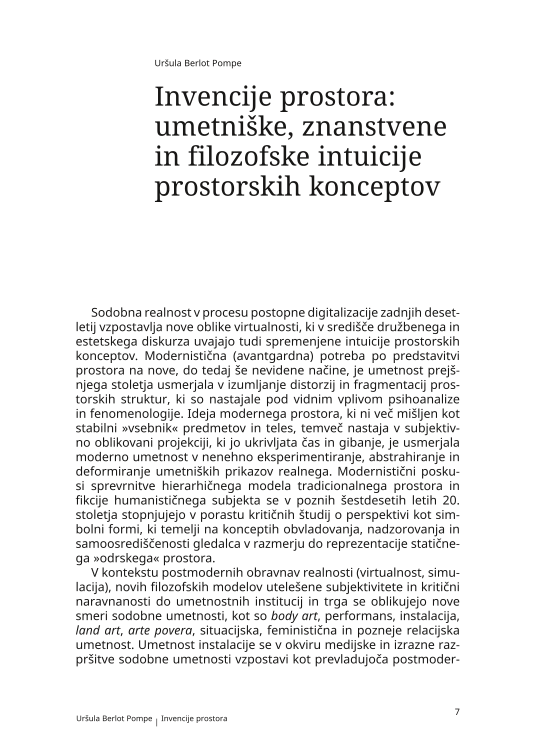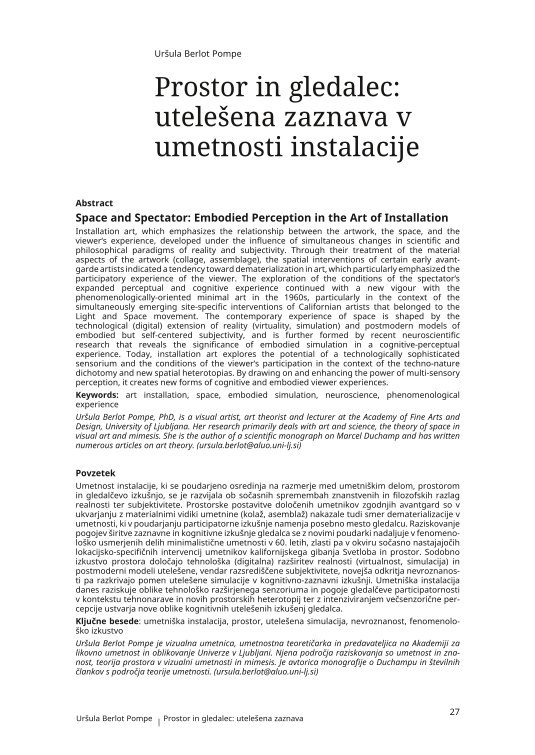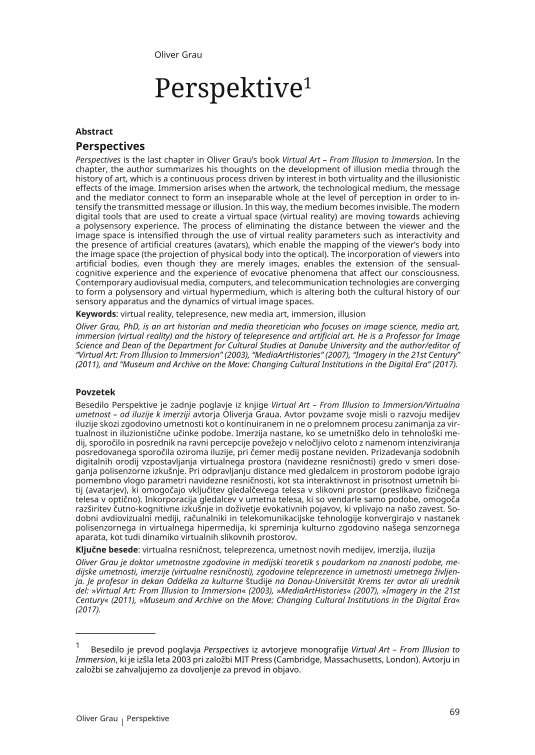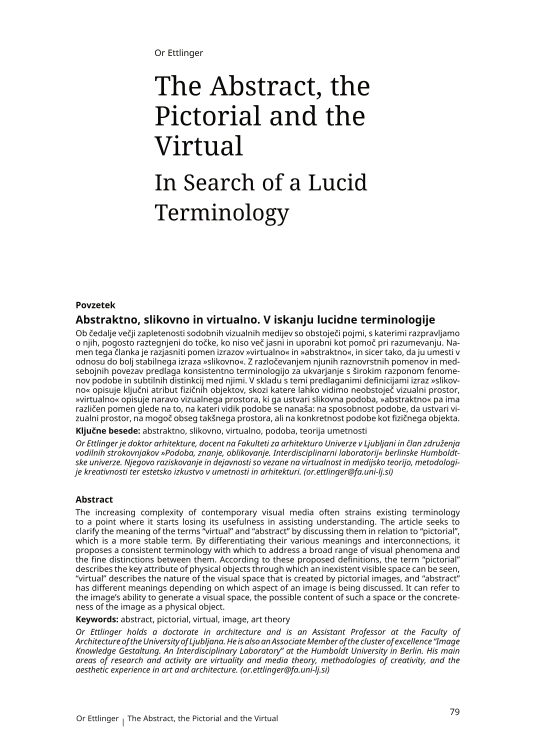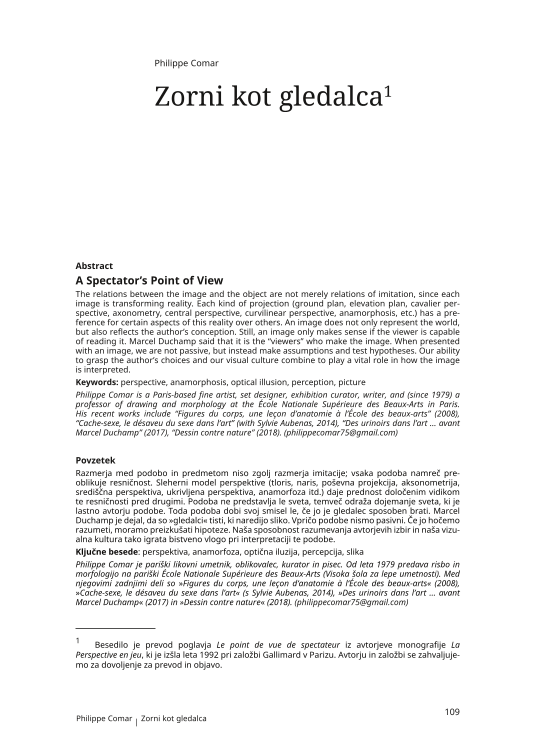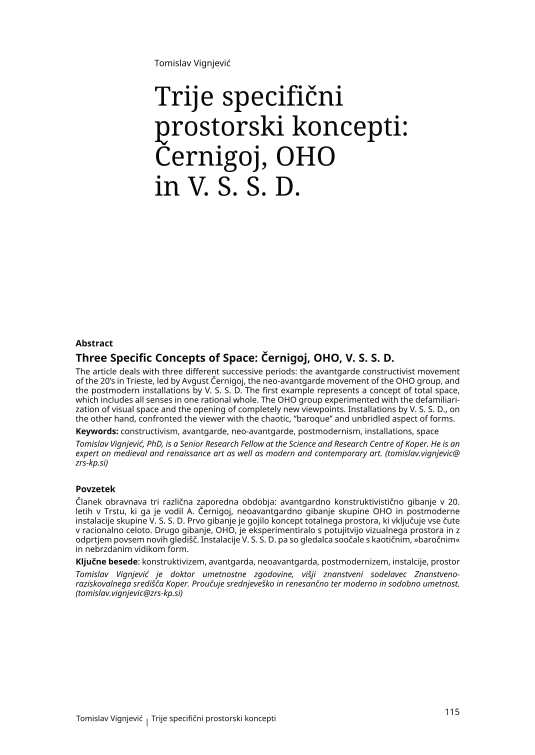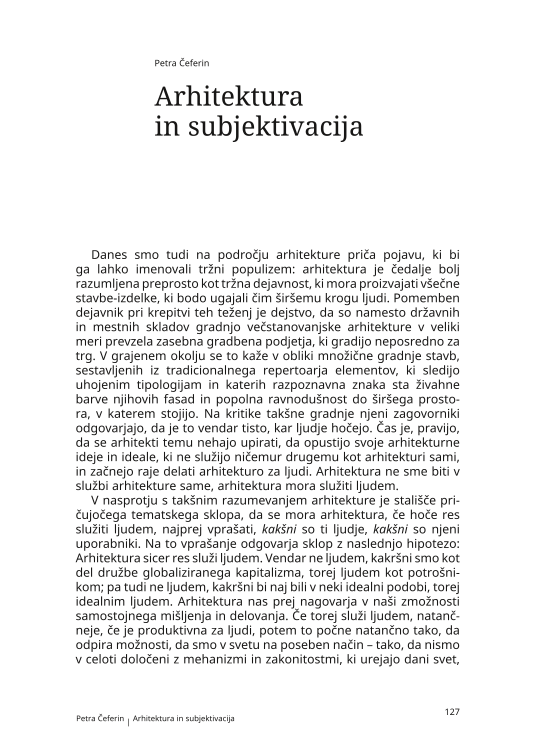Inventions of Space: Artistic, Scientific, and Philosophical Intuitions of Spatial Concepts
(
Sodobna realnost v procesu postopne digitalizacije zadnjih desetletij vzpostavlja nove oblike virtualnosti, ki v središče družbenega in estetskega diskurza uvajajo tudi spremenjene intuicije prostorskih konceptov. Modernistična (avantgardna) potreba po predstavitvi prostora na nove, do tedaj še nevidene načine, je umetnost prejšnjega stoletja usmerjala v izumljanje distorzij in fragmentacij prostorskih struktur, ki so nastajale pod vidnim vplivom psihoanalize in fenomenologije. Ideja modernega prostora, ki ni več mišljen kot stabilni »vsebnik« predmetov in teles, temveč nastaja v subjektivno oblikovani projekciji, ki jo ukrivljata čas in gibanje, je usmerjala moderno umetnost v nenehno eksperimentiranje, abstrahiranje in deformiranje umetniških prikazov realnega. Modernistični poskusi sprevrnitve hierarhičnega modela tradicionalnega prostora in fikcije humanističnega subjekta se v poznih šestdesetih letih 20. stoletja stopnjujejo v porastu kritičnih študij o perspektivi kot simbolni formi, ki temelji na konceptih obvladovanja, nadzorovanja in samoosrediščenosti gledalca v razmerju do reprezentacije statičnega »odrskega« prostora.
Through the interpretation of Foucault‘s notion of heterotopias, the article attempts to tackle the space of art. What is it, what are its characteristics and is it possible to speak of a privileged artistic space? The dominant type of gallery space for modern and contemporary art, the white cube, often appears as a possibility for some kind of otherness, an alteration of exhibited objects and their mutual relations. In this way, it bears certain similarities with Foucault‘s concept. The author‘s reading of heterotopia, however, avoids reducing this concept to existing places and their properties, and the term is instead treated as a relational notion that makes visible the splitting of space and its asymmetry. The second concept, exposition, attempts to shift the core of heterotopia in the direction of the situation-event, which creates non-places as spaces of in-betweenness, cutting a gap in the existing order. Instead of naming and describing the physical space of art, the author proposes the notion of an impossible space of in-betweenness as a topological twist or as the non-place of art.
Installation art, which emphasizes the relationship between the artwork, the space, and the viewer‘s experience, developed under the influence of simultaneous changes in scientific and philosophical paradigms of reality and subjectivity. Through their treatment of the material aspects of the artwork (collage, assemblage), the spatial interventions of certain early avantgarde artists indicated a tendency toward dematerialization in art, which particularly emphasized the participatory experience of the viewer. The exploration of the conditions of the spectator‘s expanded perceptual and cognitive experience continued with a new vigour with the phenomenologically-oriented minimal art in the 1960s, particularly in the context of the simultaneously emerging site-specific interventions of Californian artists that belonged to the Light and Space movement. The contemporary experience of space is shaped by the technological (digital) extension of reality (virtuality, simulation) and postmodern models of embodied but self-centered subjectivity, and is further formed by recent neuroscientific research that reveals the significance of embodied simulation in a cognitive-perceptual experience. Today, installation art explores the potential of a technologically sophisticated sensorium and the conditions of the viewer‘s participation in the context of the techno-nature dichotomy and new spatial heterotopias. By drawing on and enhancing the power of multi-sensory perception, it creates new forms of cognitive and embodied viewer experiences.
The paper deals with the conceptions of space in contemporary neuroscience, philosophy and the history of science. In the introduction, the author discusses a dispute between Albert Einstein and Henri Bergson in which, apart from the relationship between science and philosophy, the issue of the nature of space was addressed as well. Next, we examine the fundamental shift in scientific thought regarding questions that were beyond the capabilities of the experiment. The questions regarding the nature of space migrated to the realm of the philosophy of science and were no longer the subject of direct scientific discussion. The philosophy of science separated itself from science. The author also discusses Aristotle’s treatment of the continuum of space and the associated Zeno aporias, which have significantly influenced all subsequent theories of space. Modern neuroscientific research on the representations of space in the brain is covered in the article as well.
Perspectives is the last chapter in Oliver Grau’s book Virtual Art – From Illusion to Immersion. In the chapter, the author summarizes his thoughts on the development of illusion media through the history of art, which is a continuous process driven by interest in both virtuality and the illusionistic effects of the image. Immersion arises when the artwork, the technological medium, the message and the mediator connect to form an inseparable whole at the level of perception in order to intensify the transmitted message or illusion. In this way, the medium becomes invisible. The modern digital tools that are used to create a virtual space (virtual reality) are moving towards achieving a polysensory experience. The process of eliminating the distance between the viewer and the image space is intensified through the use of virtual reality parameters such as interactivity and the presence of artificial creatures (avatars), which enable the mapping of the viewer’s body into the image space (the projection of physical body into the optical). The incorporation of viewers into artificial bodies, even though they are merely images, enables the extension of the sensual-cognitive experience and the experience of evocative phenomena that affect our consciousness. Contemporary audiovisual media, computers, and telecommunication technologies are converging to form a polysensory and virtual hypermedium, which is altering both the cultural history of our sensory apparatus and the dynamics of virtual image spaces.
The increasing complexity of contemporary visual media often strains existing terminology to a point where it starts losing its usefulness in assisting understanding. The article seeks to clarify the meaning of the terms “virtual” and “abstract” by discussing them in relation to “pictorial”, which is a more stable term. By differentiating their various meanings and interconnections, it proposes a consistent terminology with which to address a broad range of visual phenomena and the fine distinctions between them. According to these proposed definitions, the term “pictorial” describes the key attribute of physical objects through which an inexistent visible space can be seen, “virtual” describes the nature of the visual space that is created by pictorial images, and “abstract” has different meanings depending on which aspect of an image is being discussed. It can refer to the image’s ability to generate a visual space, the possible content of such a space or the concreteness of the image as a physical object.
The article discusses ways in which various interpretations of the photographic medium establish relationships with the concept of space; more precisely, the space that is hiding behind what we understand as photography. The discussion follows from the assumption that space should, at least at first glance, play a key role in photography, even though its relevance to the medium is not discussed as often as one would perhaps expect. Even more curious is the fact that in the context of photography, the concept of time is much more commonly discussed. The author shows that in photography, the concept of space can be found on various levels and in different modes, from spatial technologies such as camera obscura and linear perspective, which are close to the very essence of the photographic medium, to the spatial relationships that are constituted within photographic practices, as well as the social and institutional spaces in which meanings of individual photographs are constituted. In all of these cases, the concept of space tends to be reflexive -the analysis leads one to learn more about different approaches to photography than about space itself.
The relations between the image and the object are not merely relations of imitation, since each image is transforming reality. Each kind of projection (ground plan, elevation plan, cavalier perspective, axonometry, central perspective, curvilinear perspective, anamorphosis, etc.) has a preference for certain aspects of this reality over others. An image does not only represent the world, but also reflects the author’s conception. Still, an image only makes sense if the viewer is capable of reading it. Marcel Duchamp said that it is the “viewers” who make the image. When presented with an image, we are not passive, but instead make assumptions and test hypotheses. Our ability to grasp the author’s choices and our visual culture combine to play a vital role in how the image is interpreted.
The article deals with three different successive periods: the avantgarde constructivist movement of the 20’s in Trieste, led by Avgust Černigoj, the neo-avantgarde movement of the OHO group, and the postmodern installations by V. S. S. D. The first example represents a concept of total space, which includes all senses in one rational whole. The OHO group experimented with the defamiliarization of visual space and the opening of completely new viewpoints. Installations by V. S. S. D., on the other hand, confronted the viewer with the chaotic, ’‘baroque’’ and unbridled aspect of forms.
Danes smo tudi na področju arhitekture priča pojavu, ki bi ga lahko imenovali tržni populizem: arhitektura je čedalje bolj razumljena preprosto kot tržna dejavnost, ki mora proizvajati všečne stavbe-izdelke, ki bodo ugajali čim širšemu krogu ljudi. Pomemben dejavnik pri krepitvi teh teženj je dejstvo, da so namesto državnih in mestnih skladov gradnjo večstanovanjske arhitekture v veliki meri prevzela zasebna gradbena podjetja, ki gradijo neposredno za trg. V grajenem okolju se to kaže v obliki množične gradnje stavb, sestavljenih iz tradicionalnega repertoarja elementov, ki sledijo uhojenim tipologijam in katerih razpoznavna znaka sta živahne barve njihovih fasad in popolna ravnodušnost do širšega prostora, v katerem stojijo. Na kritike takšne gradnje njeni zagovorniki odgovarjajo, da je to vendar tisto, kar ljudje hočejo. Čas je, pravijo, da se arhitekti temu nehajo upirati, da opustijo svoje arhitekturne ideje in ideale, ki ne služijo ničemur drugemu kot arhitekturi sami, in začnejo raje delati arhitekturo za ljudi. Arhitektura ne sme biti v službi arhitekture same, arhitektura mora služiti ljudem.
A Landscape of Multiplicities: The Production of Subjectivity in Álvaro Siza’s Malagueira Neighbourhood
(
This article discusses the design decision-making and the post-occupancy processes of the Malagueira neighbourhood, a housing estate designed by Álvaro Siza in 1977 in the Portuguese city of Évora. In this article, I use an empirical approach supported by an ethnographic research to discuss the production of subjectivity in the Malagueira neighbourhood. In the first section of the article, I examine the extent to which ownership played an important role in the formation of the neighbourhood as a whole of singularities. Then I analyse three social-spatial conditions (patios, walls and streets) in which the design decision-making process of the Malagueira plan triggered a mediation between the ontological figures of the “one” and the “multiple”. In the following section, I discuss the immanent tension between authority and subjectivity reviewing the project’s reception. In the conclusion, I explore Antonio Negri’s ontological definition of the “multitude” to highlight how the Malagueira neighbourhood illustrates the interdependence between design decisions and processes of subjectivation in the formation of a landscape of “multiplicities”.
The article examines the relation between architecture and its users. Contrary to the predominant position, which states that architecture should focus on people instead of focusing on architectural invention, the article argues that the dilemma itself is irrelevant. It is precisely when architecture is well constructed, when it is the result of successful architectural invention, that it is also good for people. Here, the author stresses that architecture should not focus on benefiting people as they already are – architects should instead take into account that people, in all of their human complexity, are co-created by architecture. The article therefore argues that architecture has a creative or transformative capacity: it not only creates its objects/products, but also co-creates its (architectural) users. This property of architecture stems from its inner structure, which is also the inner structure of the objects that architecture creates. The article develops this argument through an examination of the University Medical Centre Ljubljana designed by architect Stanko Kristl.
The Collective, the Individual and Self-Determination: A Metabolist Project in the Architecture of PREVI Lima
(
PREVI Lima—Lima’s Experimental Housing Project, 1968–1975—has gained worldwide recognition in the architecture and urban design fields as a relevant model for urban development. PREVI neighbours quickly started to appropriate the units, building and transforming the neighbourhood in a field of freedom, particularly in the facades, which became canvases for their social aspirations. As a result, the houses evolved beyond any architectural expectations, and every addition reinforced the residents’ self-determination, revealing the struggles of the overlapping cultures, and expressing the vivid processes of consolidation of the Peruvian culture. The ideas of participation, individualization of the architecture and the freedom to build their own dwelling conditions were fully achieved, albeit in a completely different way than planned.
The interview is based on the premise that architecture creates conditions for human habitation. The interviewee, philosopher Rado Riha, emphasizes that we can answer the question of how architecture achieves this only after we have answered the question of what is human habitation. In his opinion, the human being possesses an endless capability of self-creation. Creative architectural thought encourages this very capability, and leads one to constant reinvention. Architecture facilitates this constant reinvention by perpetually redefining itself in each historical context.
The article analyses the presence of erotica and pornography within two genres of extreme metal music: black metal (BM) and porno-gore grind (PGG). By contextualizing it through a prism of exploitation and sexism, the authors discuss the heterosexual male domination of these genres. The authors employ a porn studies approach, dealing with pornography as an important social phenomenon. Subcultural studies, particularly when it comes to punk and metal, also provide a theoretical background to the article. The main source of the presented research are webzines: in the case of BM, their visual components, and in the case of PGG, visual and other multimedia elements.




